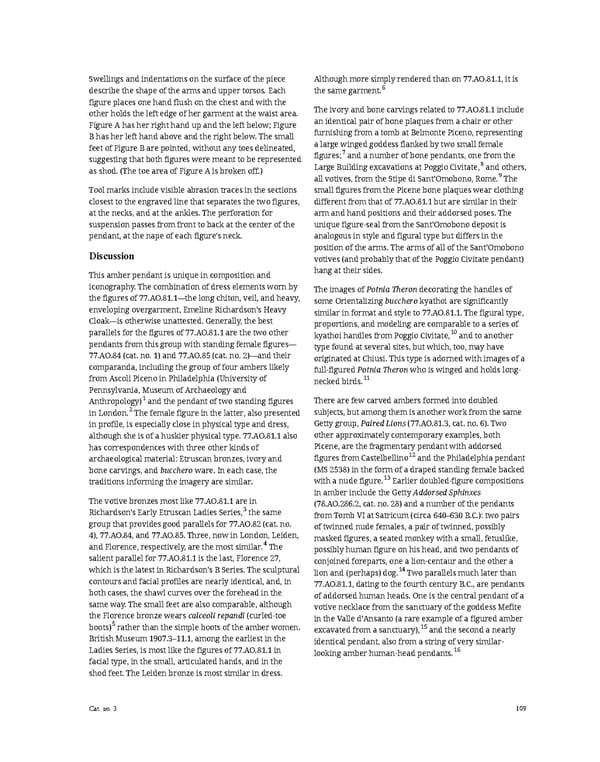Swellings and indentations on the surface of the piece Although more simply rendered than on 77.AO.81.1, it is describe the shape of the arms and upper torsos. Each the same garment.6 figure places one hand flush on the chest and with the other holds the left edge of her garment at the waist area. The ivory and bone carvings related to 77.AO.81.1 include Figure A has her right hand up and the left below; Figure an identical pair of bone plaques from a chair or other B has her left hand above and the right below. The small furnishing from a tomb at Belmonte Piceno, representing feet of Figure B are pointed, without any toes delineated, a large winged goddess flanked by two small female figures;7 and a number of bone pendants, one from the suggesting that both figures were meant to be represented 8 as shod. (The toe area of Figure A is broken off.) Large Building excavations at Poggio Civitate, and others, all votives, from the Stipe di Sant’Omobono, Rome.9 The Tool marks include visible abrasion traces in the sections small figures from the Picene bone plaques wear clothing closest to the engraved line that separates the two figures, different from that of 77.AO.81.1 but are similar in their at the necks, and at the ankles. The perforation for arm and hand positions and their addorsed poses. The suspension passes from front to back at the center of the unique figure-seal from the Sant’Omobono deposit is pendant, at the nape of each figure’s neck. analogous in style and figural type but differs in the Discussion position of the arms. The arms of all of the Sant’Omobono votives (and probably that of the Poggio Civitate pendant) This amber pendant is unique in composition and hang at their sides. iconography. The combination of dress elements worn by The images of Potnia Theron decorating the handles of the figures of 77.AO.81.1—the long chiton, veil, and heavy, some Orientalizing bucchero kyathoi are significantly enveloping overgarment, Emeline Richardson’s Heavy similar in format and style to 77.AO.81.1. The figural type, Cloak—is otherwise unattested. Generally, the best proportions, and modeling are comparable to a series of parallels for the figures of 77.AO.81.1 are the two other kyathoi handles from Poggio Civitate,10 and to another pendants from this group with standing female figures— type found at several sites, but which, too, may have 77.AO.84(cat. no. 1) and 77.AO.85 (cat. no. 2)—and their originated at Chiusi. This type is adorned with images of a comparanda, including the group of four ambers likely full-figured Potnia Theron who is winged and holds long- from Ascoli Piceno in Philadelphia (University of necked birds.11 Pennsylvania, Museum of Archaeology and Anthropology)1and the pendant of two standing figures There are few carved ambers formed into doubled in London.2 The female figure in the latter, also presented subjects, but among them is another work from the same in profile, is especially close in physical type and dress, Getty group, Paired Lions (77.AO.81.3, cat. no. 6). Two although she is of a huskier physical type. 77.AO.81.1 also other approximately contemporary examples, both has correspondences with three other kinds of Picene, are the fragmentary pendant with addorsed archaeological material: Etruscan bronzes, ivory and figures from Castelbellino12 and the Philadelphia pendant bone carvings, and bucchero ware. In each case, the (MS 2538) in the form of a draped standing female backed traditions informing the imagery are similar. with a nude figure.13 Earlier doubled-figure compositions in amber include the Getty Addorsed Sphinxes The votive bronzes most like 77.AO.81.1 are in (78.AO.286.2, cat. no. 28) and a number of the pendants Richardson’s Early Etruscan Ladies Series,3 the same from Tomb VI at Satricum (circa 640–630 B.C.): two pairs group that provides good parallels for 77.AO.82 (cat. no. of twinned nude females, a pair of twinned, possibly 4), 77.AO.84, and 77.AO.85. Three, now in London, Leiden, masked figures, a seated monkey with a small, fetuslike, and Florence, respectively, are the most similar.4 The possibly human figure on his head, and two pendants of salient parallel for 77.AO.81.1 is the last, Florence 27, conjoined foreparts, one a lion-centaur and the other a which is the latest in Richardson’s B Series. The sculptural lion and (perhaps) dog.14 Two parallels much later than contours and facial profiles are nearly identical, and, in 77.AO.81.1, dating to the fourth century B.C., are pendants both cases, the shawl curves over the forehead in the of addorsed human heads. One is the central pendant of a same way. The small feet are also comparable, although votive necklace from the sanctuary of the goddess Mefite the Florence bronze wears calceoli repandi (curled-toe in the Valle d’Ansanto (a rare example of a figured amber boots)5 rather than the simple boots of the amber women. excavated from a sanctuary),15 and the second a nearly British Museum 1907.3–11.1, among the earliest in the identical pendant, also from a string of very similar- Ladies Series, is most like the figures of 77.AO.81.1 in looking amber human-head pendants.16 facial type, in the small, articulated hands, and in the shod feet. The Leiden bronze is most similar in dress. Cat. no. 3 109
 Ancient Carved Ambers in the J. Paul Getty Museum Page 118 Page 120
Ancient Carved Ambers in the J. Paul Getty Museum Page 118 Page 120